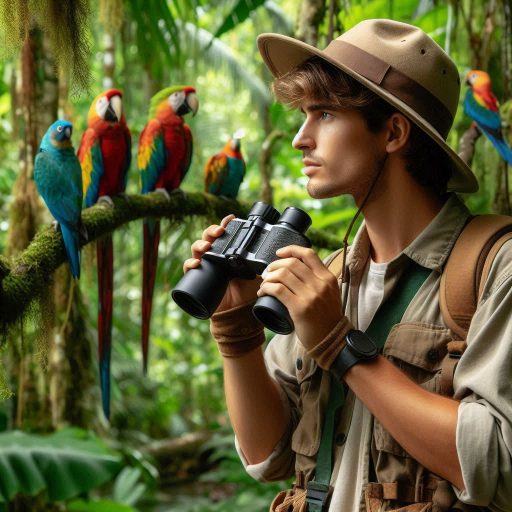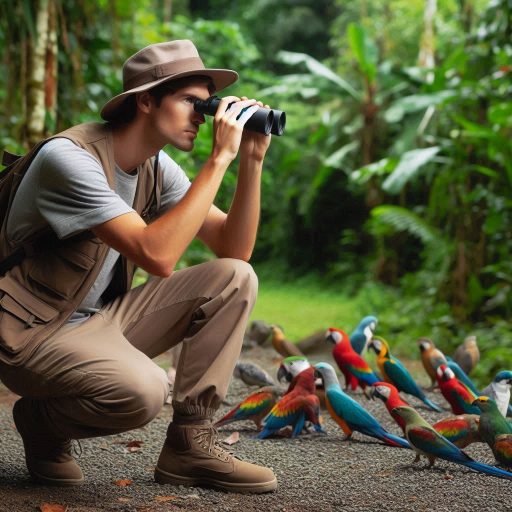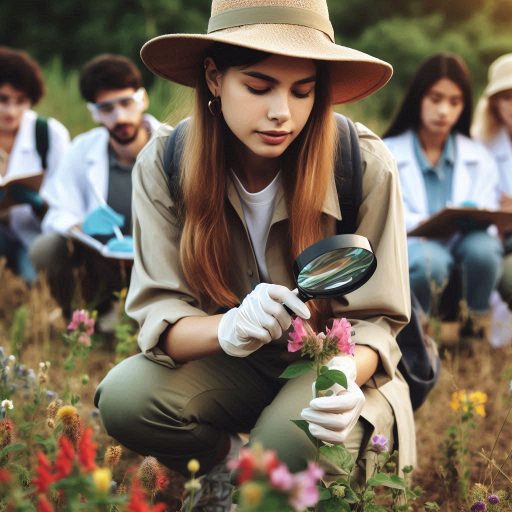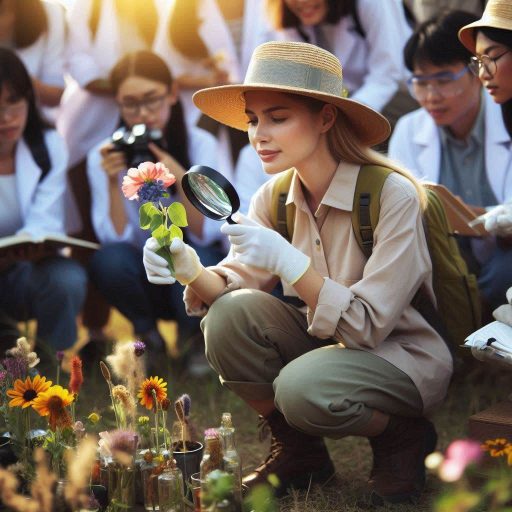Introduction
Wildlife rehabilitation is a critical practice focused on the care and recovery of injured, orphaned, or sick animals, aiming to return them to their natural habitats.
This essential process plays a significant role in global conservation efforts, as it helps maintain biodiversity and protect vulnerable species.
Wildlife rehabilitators address the impact of human activities, habitat loss, and environmental changes, ensuring that affected wildlife can recover and thrive.
The importance of wildlife rehabilitation extends beyond individual animal care.
It contributes to the overall health of ecosystems, as rehabilitated animals can play their vital roles within their habitats.
For instance, birds of prey help control rodent populations, while pollinators like bees and butterflies are crucial for plant reproduction.
By restoring injured or orphaned animals to the wild, rehabilitation efforts help sustain these ecological balances.
Zoologists play a pivotal role in wildlife rehabilitation, utilizing their extensive knowledge of animal behavior, physiology, and ecology to guide recovery efforts.
These professionals assess the health of injured animals, diagnose conditions, and develop recovery plans tailored to each animal’s specific needs.
They provide crucial medical care, which may include wound treatment, nutritional support, and behavioral rehabilitation.
Through their expertise, zoologists ensure that animals receive the best possible care, enhancing their chances of successful recovery and reintroduction to the wild.
Definition of Wildlife Rehabilitation
What Wildlife Rehabilitation Entails and How It Differs from Traditional Veterinary Care
Wildlife rehabilitation involves the treatment and care of injured, sick, or orphaned wild animals.
This process aims to restore these animals to health so they can return to their natural habitats.
Unlike traditional veterinary care, which focuses primarily on domestic pets, wildlife rehabilitation addresses the unique needs of wild species.
Zoologists and wildlife rehabilitators often work together to provide specialized care tailored to each animal’s requirements.
Wildlife rehabilitation encompasses various activities, including rescue, medical treatment, and post-recovery care.
Rehabilitators assess the health of wildlife and determine the best course of action for recovery.
They provide medical treatment, often collaborating with veterinarians to address specific injuries or illnesses.
This care may include wound treatment, surgery, and rehabilitation therapy.
The goal is always to prepare the animal for eventual release back into the wild.
One significant difference between wildlife rehabilitation and traditional veterinary care is the focus on release.
Traditional veterinarians prioritize pet health and well-being, often maintaining a long-term client relationship.
In contrast, wildlife rehabilitators aim to rehabilitate animals for reintroduction into their natural environments.
They provide care only until the animals are fit to survive independently.
The Goals of Wildlife Rehabilitation, Including Returning Animals to Their Natural Habitat
The primary goals of wildlife rehabilitation include restoring health and ensuring successful reintegration into the wild.
Rehabilitators assess animals’ physical conditions, as well as their behavioral readiness for release.
They work to minimize human dependency, allowing the animals to regain their natural instincts.
Education plays a crucial role in rehabilitation, as it helps prepare animals for life in the wild.
Rehabilitation also involves providing a safe environment for recovery.
Wild animals often experience stress from human interaction, so rehabilitators strive to create a low-stress environment.
This may include using quiet spaces and minimizing direct contact with humans.
Such practices help the animals recover without developing further reliance on humans.
Moreover, rehabilitators must educate the public about wildlife conservation and the importance of protecting natural habitats.
This outreach fosters awareness of the challenges wildlife face and encourages community involvement.
By promoting conservation efforts, rehabilitators hope to reduce the number of animals needing care in the first place.
Wildlife rehabilitation is a specialized field focused on caring for wild animals.
It differs from traditional veterinary practices in its goals and methods.
The primary aim is to restore injured or orphaned animals to health and prepare them for release back into their habitats.
By understanding and implementing effective rehabilitation practices, wildlife rehabilitators significantly contribute to the recovery of wildlife populations.
Read: Exploring the Different Branches of Geology
Zoologists’ Expertise in Wildlife Rehabilitation
The Specialized Knowledge and Skills That Zoologists Bring to Wildlife Rehabilitation
Zoologists play a crucial role in wildlife rehabilitation through their specialized knowledge and skills.
Their extensive education in animal biology, behavior, and ecology equips them to assess and treat various species effectively.
This expertise allows zoologists to understand the specific needs of different animals, from mammals to birds and reptiles.
One significant skill zoologists possess is understanding animal behavior.
They can identify signs of stress, illness, or injury, which is vital for providing appropriate care.
This knowledge helps rehabilitators create strategies to minimize human interaction and promote natural behaviors during recovery.
Additionally, zoologists are trained in animal husbandry, enabling them to provide proper nutrition and habitat requirements for different species.
Zoologists also possess a strong foundation in conservation biology.
They understand the ecological roles of various species and the importance of preserving their natural habitats.
This perspective guides their rehabilitation efforts, ensuring that animals are not only treated but also prepared for successful reintroduction into the wild.
Their knowledge helps them develop rehabilitation programs that prioritize the long-term survival of wildlife populations.
How Zoologists Collaborate with Veterinarians, Biologists, and Other Professionals in the Rehabilitation Process
Collaboration is essential in wildlife rehabilitation, and zoologists often work closely with veterinarians, biologists, and other professionals.
This teamwork ensures a comprehensive approach to animal care.
Veterinarians provide medical expertise, diagnosing and treating injuries or illnesses that require specialized medical attention.
Zoologists complement this by offering insights into the animal‘s natural behaviors and needs, which helps shape recovery plans.
Biologists contribute their knowledge of ecosystems and species-specific behaviors, aiding in developing rehabilitation protocols.
They help zoologists understand the environmental factors influencing wildlife health and survival.
Together, they create rehabilitation programs that reflect the best practices for specific species.
Moreover, zoologists often engage with wildlife agencies and conservation organizations.
This collaboration is crucial for identifying areas where rehabilitation efforts can make a significant impact.
By sharing data and research, zoologists can help inform broader conservation strategies and policies.
They advocate for habitat preservation and responsible wildlife interactions, which further supports rehabilitation goals.
Zoologists bring invaluable expertise to wildlife rehabilitation.
Their knowledge of animal behavior, conservation, and husbandry enhances the care provided to injured or orphaned wildlife.
Through collaboration with veterinarians, biologists, and other professionals, zoologists help ensure a comprehensive approach to rehabilitation.
This teamwork ultimately improves the chances of successful recovery and reintroduction of wildlife back into their natural habitats.
Read: Top Skills Needed for a Successful Geology Career
Role of Zoologists in Animal Care
The Hands-On Work Zoologists Do in Caring for Injured or Orphaned Wildlife
Zoologists play a vital role in the hands-on care of injured or orphaned wildlife.
Their responsibilities often begin with the initial rescue and transport of animals in need.
They assess the immediate condition of these animals, providing initial care and stabilization.
This may involve cleaning wounds, administering fluids, or implementing basic medical interventions.
Once the animals are in rehabilitation facilities, zoologists are responsible for creating and maintaining suitable environments.
They design enclosures that mimic the animals’ natural habitats, ensuring they have space to move, hide, and explore.
This setup helps reduce stress and supports the animals’ physical and mental well-being during recovery.
Zoologists also monitor the daily health and behavior of each animal.
They feed animals a proper diet based on their species and nutritional needs, often preparing specialized meals.
Additionally, they track the animals‘ food intake and weight to ensure they are regaining strength.
This hands-on work is crucial for guiding further medical treatments and rehabilitation strategies.
Zoologists engage in behavioral training to encourage natural instincts in animals.
This may include exercises to promote hunting or foraging skills, crucial for animals being prepared for release.
They ensure that wildlife maintains their instincts and does not become overly reliant on human care.
How Zoologists Help Assess the Health and Behavior of Animals in Rehabilitation
Assessing the health and behavior of rehabilitating animals is a critical aspect of a zoologist‘s role.
They conduct thorough health evaluations upon arrival, looking for signs of injury, illness, or malnutrition.
This assessment includes monitoring vital signs, examining physical conditions, and checking for parasites.
By identifying health issues early, zoologists can implement timely treatments.
Behavioral assessments are equally important.
Zoologists observe how animals interact with their environments and other wildlife.
They look for signs of stress, fear, or aggression, which can indicate how well an animal is adjusting to rehabilitation.
These observations inform strategies for minimizing stress and enhancing recovery.
Regular assessments also help determine an animal’s readiness for release.
Zoologists evaluate the physical condition and behavioral capabilities, ensuring that the animal can survive independently in the wild.
They assess hunting skills, social behaviors, and overall fitness before making the decision to release.
Additionally, zoologists maintain detailed records of each animal‘s progress.
These records include medical treatments, feeding schedules, behavioral observations, and recovery milestones.
This documentation aids in evaluating the effectiveness of rehabilitation techniques and provides insights for future cases.
Zoologists are integral to the hands-on care of injured or orphaned wildlife.
Their work includes initial rescue, habitat design, daily care, and behavioral training.
They assess the health and behavior of animals to ensure effective rehabilitation.
Through their expertise, zoologists significantly enhance the chances of successful recovery and reintegration of wildlife into their natural environments.
Read: The Future of Botany: Emerging Fields and Innovations
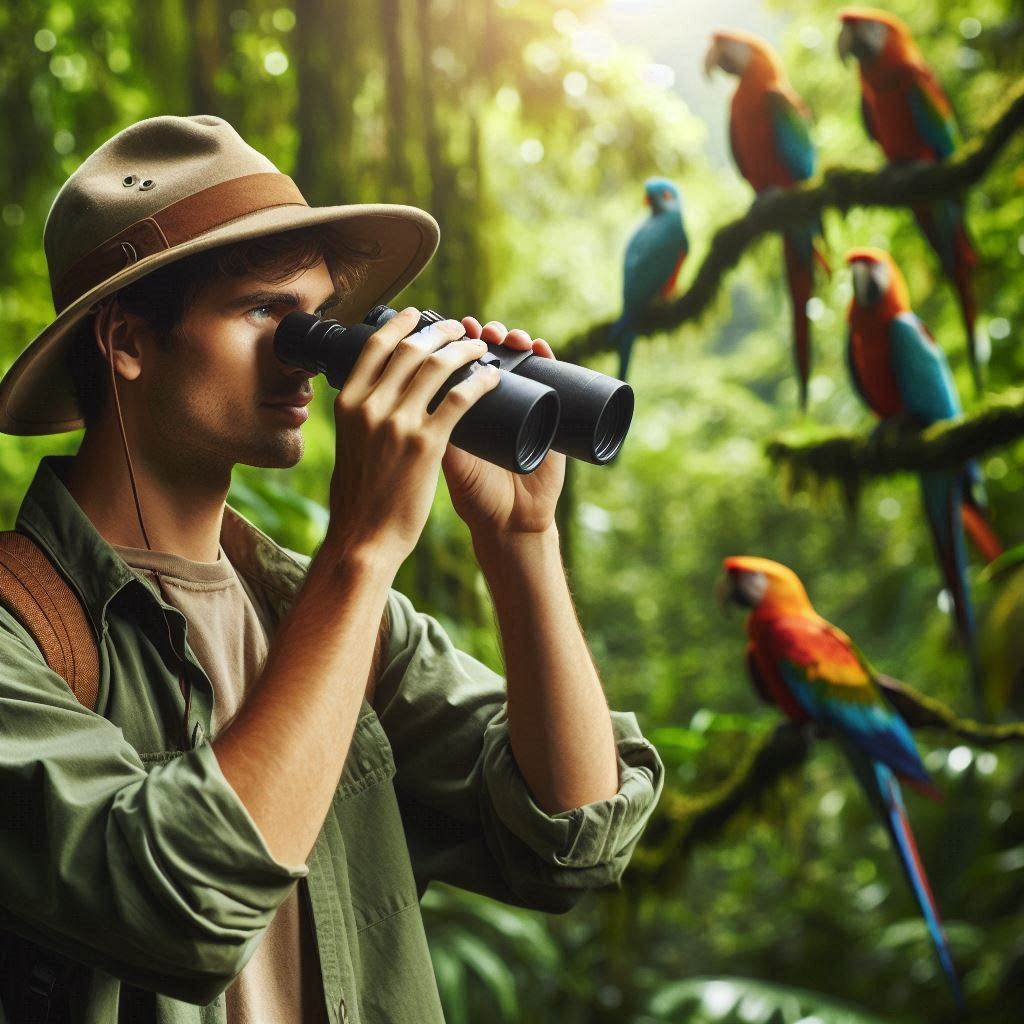
Training and Education for Zoologists in Wildlife Rehabilitation
The Typical Educational Background and Training Required for Zoologists Working in Wildlife Rehabilitation
Zoologists pursuing careers in wildlife rehabilitation typically begin with a strong educational foundation in biology or zoology.
Most hold at least a bachelor‘s degree in these fields, which provides essential knowledge of animal anatomy, physiology, and behavior.
Some zoologists may choose to further their education by obtaining a master‘s or even a doctoral degree, focusing on wildlife biology, ecology, or conservation.
In addition to formal education, hands-on experience is crucial.
Many zoologists complete internships or volunteer positions with wildlife rehabilitation centers, zoos, or conservation organizations.
These opportunities allow them to apply their academic knowledge in real-world settings, gaining practical skills in animal care, rehabilitation techniques, and species-specific needs.
Training programs in wildlife rehabilitation are also available and often include specialized courses.
These programs cover essential topics such as animal handling, veterinary care, nutrition, and behavioral assessment.
Certification programs, offered by organizations like the National Wildlife Rehabilitators Association (NWRA) or the International Wildlife Rehabilitation Council (IWRC), provide further credentials that enhance a zoologist‘s qualifications.
Hands-on training is crucial for developing the skills necessary to work effectively with various wildlife species.
This includes learning to administer medications, provide emergency care, and perform basic surgical procedures under supervision.
The Importance of Continuing Education and Professional Development in This Field
Continuing education and professional development are vital in wildlife rehabilitation due to the evolving nature of the field.
Zoologists must stay current with new research, rehabilitation techniques, and best practices to provide the highest standard of care for animals.
Ongoing education ensures they are aware of the latest advancements in veterinary medicine, conservation strategies, and ethical considerations in wildlife care.
Many professional organizations offer workshops, webinars, and conferences to facilitate ongoing learning.
These events provide networking opportunities with other professionals in the field, fostering collaboration and knowledge sharing.
Engaging with peers allows zoologists to learn from one another‘s experiences and adopt innovative approaches to rehabilitation.
Continuing education also supports compliance with regulations and standards in wildlife rehabilitation.
Many states and organizations require professionals to maintain certifications through regular training.
This requirement ensures that zoologists remain informed about legal obligations and ethical practices, ultimately benefiting both the animals they care for and the communities they serve.
The path to becoming a zoologist in wildlife rehabilitation typically involves a solid educational background, hands-on experience, and specialized training.
Continuing education and professional development are crucial for maintaining high standards in animal care and adapting to new challenges in the field.
By prioritizing ongoing learning, zoologists can enhance their skills and contribute to effective wildlife rehabilitation efforts.
Read: What Does a Geologist Do? Career Overview and Insights
Research and Conservation Efforts
How Zoologists Contribute to Research on Wildlife Diseases, Behavior, and Habitat Conservation
Zoologists play a crucial role in advancing research on wildlife diseases, behavior, and habitat conservation.
Their expertise allows them to conduct studies that enhance our understanding of various species and their ecological roles.
In the area of wildlife diseases, zoologists investigate the causes and effects of illnesses affecting animal populations.
They collect samples and data to identify pathogens and assess the health of different species.
By understanding disease dynamics, zoologists can help develop strategies for managing outbreaks and preventing the spread of infections.
This research is essential not only for the health of wildlife but also for safeguarding human health, as many zoonotic diseases can transfer between species.
Zoologists also study animal behavior to understand how species interact with their environments and each other.
This research often focuses on mating, foraging, and social behaviors.
By observing and documenting these behaviors, zoologists can provide valuable insights into the adaptations that help species thrive in their natural habitats.
This knowledge is critical for developing effective conservation strategies aimed at protecting endangered species and their ecosystems.
Furthermore, zoologists contribute to habitat conservation efforts by assessing the impacts of human activities on wildlife.
They study habitat loss, fragmentation, and degradation, providing data that inform conservation planning.
By collaborating with conservation organizations, zoologists help design and implement restoration projects that aim to improve habitats for various species.
Their research supports evidence-based decision-making to enhance biodiversity and ecosystem health.
The Role of Wildlife Rehabilitation Centers in Educating the Public and Raising Awareness About Conservation Issues
Wildlife rehabilitation centers play a vital role in educating the public and raising awareness about conservation issues.
These centers often serve as community hubs for learning about local wildlife and the challenges they face.
By offering educational programs, workshops, and tours, rehabilitation centers provide opportunities for people to engage with wildlife conservation.
Public education focuses on several key areas, including the importance of protecting natural habitats, the impact of human activities on wildlife, and how individuals can contribute to conservation efforts.
Many centers develop outreach programs for schools, allowing children to learn about wildlife and conservation through hands-on experiences.
This early education fosters a sense of responsibility and connection to nature, encouraging future generations to become advocates for wildlife protection.
In addition to educational programs, wildlife rehabilitation centers raise awareness about specific conservation issues.
They often highlight the threats facing particular species, such as habitat destruction, climate change, and pollution.
By sharing success stories of rehabilitated animals, centers inspire the public to support conservation initiatives.
This storytelling approach makes conservation issues more relatable and urgent.
Moreover, rehabilitation centers often collaborate with local and national conservation organizations.
These partnerships help amplify their educational efforts and expand their reach.
By working together, they can organize community events, fundraising campaigns, and advocacy initiatives that promote wildlife conservation.
Zoologists contribute significantly to research on wildlife diseases, behavior, and habitat conservation.
Their work informs effective conservation strategies and enhances our understanding of wildlife.
Wildlife rehabilitation centers complement these efforts by educating the public and raising awareness about conservation issues.
Together, they play a critical role in fostering a culture of conservation and ensuring a sustainable future for wildlife and their habitats.
Challenges and Ethical Considerations
Common Challenges Faced by Zoologists in Wildlife Rehabilitation
Zoologists working in wildlife rehabilitation encounter several significant challenges.
One of the most pressing issues is the limited resources available to support their efforts.
Wildlife rehabilitation centers often operate on tight budgets, relying heavily on donations and grants.
This financial strain can hinder their ability to provide adequate care, equipment, and facilities for the animals.
When resources are scarce, zoologists may face difficult choices regarding which animals to prioritize for rehabilitation.
Another challenge is the increasing number of injured or orphaned animals brought to rehabilitation centers.
As human activities encroach on natural habitats, wildlife encounters with urban areas are becoming more common.
This increase puts additional pressure on rehabilitation services, often leading to overcrowded facilities.
Zoologists must work efficiently to care for more animals while maintaining high standards of care.
Balancing the needs of individual animals with the demands of a growing population can be a daunting task.
Conflicting conservation goals also pose challenges for zoologists.
Different stakeholders, including government agencies, conservation organizations, and local communities, may have varying objectives regarding wildlife management.
For example, a community might prioritize the preservation of a particular species, while another group may focus on habitat restoration.
Navigating these differing priorities can complicate rehabilitation efforts and lead to disagreements over the best course of action.
Ethical Considerations Related to Wildlife Rehabilitation
Ethical considerations are a critical aspect of wildlife rehabilitation.
One of the most challenging ethical dilemmas faced by zoologists involves decisions about euthanasia.
When an animal arrives in critical condition or suffering from irreversible injuries, zoologists must weigh the potential for recovery against the quality of life for that animal.
These decisions can be emotionally taxing and require careful consideration of the animal’s welfare.
Determining appropriate release criteria also raises ethical questions.
Zoologists must assess whether an animal can survive independently in the wild after rehabilitation.
Factors such as age, health, and behavior are considered to make these determinations.
Releasing an animal that cannot fend for itself could lead to suffering or death, while keeping a healthy animal in captivity can hinder its natural instincts.
Striking the right balance between ensuring animal welfare and promoting conservation efforts is essential.
Moreover, there are ethical implications regarding the impact of rehabilitation on wild populations.
Frequent human intervention in wildlife can disrupt natural selection processes and alter behaviors.
For instance, animals that rely too heavily on human care may struggle to adapt once released.
Zoologists must consider the long-term consequences of their rehabilitation efforts on both the individual animals and the species as a whole.
Zoologists face numerous challenges in wildlife rehabilitation, including limited resources and conflicting conservation goals.
Ethical considerations surrounding euthanasia and release criteria are significant aspects of their work.
By navigating these challenges thoughtfully, zoologists can enhance their rehabilitation efforts while prioritizing the well-being of the animals they care for.
Balancing these complex issues is essential for the success of wildlife rehabilitation and conservation initiatives.
Find Out More: Top Industries Hiring Hydrologists in 2024
Learn More: Balancing Work and Life as an Optometrist
Learn More: Common Misconceptions About the Astronomy Field
Transform Your Career Today
Unlock a personalized career strategy that drives real results. Get tailored advice and a roadmap designed just for you.
Start NowConclusion
Wildlife rehabilitation plays a vital role in conserving our planet’s biodiversity.
Zoologists are essential to this process, using their expertise to care for injured, orphaned, or sick animals.
They assess each animal’s needs, develop tailored recovery plans, and monitor progress throughout rehabilitation.
Their work ensures that these animals can safely return to their natural habitats, fostering healthier ecosystems.
The role of zoologists extends beyond immediate care.
They educate the public about wildlife issues, promoting awareness and understanding of the challenges animals face.
By collaborating with local communities and organizations, they help implement conservation strategies that protect wildlife and their habitats.
Their efforts are crucial in combating the effects of habitat destruction, pollution, and climate change.
You can support wildlife rehabilitation efforts by volunteering with local organizations or donating to wildlife rehabilitation centers.
Many facilities welcome help in various forms, from hands-on care to administrative support.
Additionally, learning about wildlife rehabilitation raises awareness and encourages others to get involved.
Consider sharing information on social media about the importance of wildlife rehabilitation and the work of zoologists.
Advocacy can lead to increased funding and resources for rehabilitation centers, allowing them to expand their reach.
Together, we can help protect wildlife and their habitats for future generations.
Embrace the chance to make a difference and support the incredible work of zoologists and wildlife rehabilitators.
Your involvement, whether through volunteering, educating others, or advocating for wildlife, contributes to a larger mission of conservation.
Every small effort counts, and together we can ensure a brighter future for wildlife around the world.
[E-Books for Sale]
The Big Book of 500 High-Paying Jobs in America: Unlock Your Earning Potential
$19.99 • 500 High-Paying Jobs • 330 pages
Explore 500 high-paying jobs in America and learn how to boost your career, earn more, and achieve success!
See All 500 High-Paying Jobs of this E-Book
1001 Professions Without a Degree: High-Paying American Jobs You Can Start Now
$19.99 • 1001 Professions Without a Degree • 174 pages
Discover 1001 high-paying jobs without a degree! Unlock career tips, skills, and success strategies for just $19.99!

